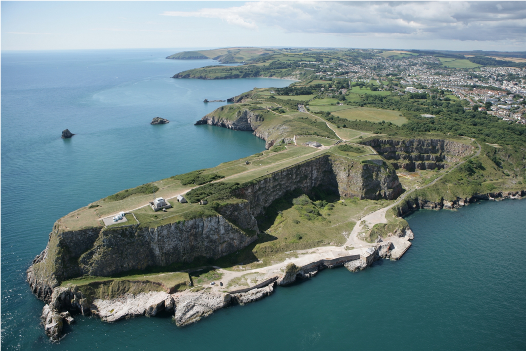
Gordon Walkden tells the story of a long-forgotten but quite exceptional range of ornamental marbles.
Geologists tend to overlook ornamental stone, but all of geology can be there - sometimes at its most challenging. Perhaps our difficulty is that we see so much in a polished stone, yet often have no idea where the stone is from. Devonshire marbles are a fine example. Their colour and diversity brought them to prominence in the Victorian era, fully at ease in aesthetic competition with foreign rivals, and yet in the 20th Century they slipped into obscurity and are now probably the least recognisable of all widely-used ornamental stones.
Figure 1. Berry Head, near Brixham Devon. The limestones were quarried into the 1950s, barely stopping short of the Napoleonic fortress at the top. Courtesy, Southwest Regional Coastal Monitoring Programme.
Devonshire marbles tell a great story, geologically and historically. Their ‘Britishness’ was branded on them by the great Victorian architect George Gilbert Scott when he used them in his Foreign Office building (1861-75) on Whitehall. We can now ‘map’ more than 70 buildings up and down Britain, and a few more abroad, with significant examples of Devonshire. There may be North American, South African and Pacific examples. Devonshire marbles are in Melbourne Cathedral.
Figure 2. The Devonian seas of South Devon. Outlines are based on present day outcrop. The original north-south extent if the South Devon Basin was far greater than this and no attempt is made to restore basins to their original dimensions.
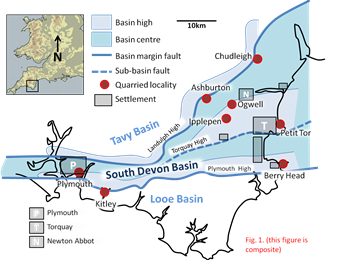 Produced from the same marble works in Plymouth and Torquay, south Devon (Fig.1) were vases, tazzas, inlaid desk sets, dressing-table sets and some magnificent stone-inlay specimen marble tables. While Devonshire marble shafts and panels became standard finery in Gothic Revival buildings, these artefacts became mansion ‘must-haves’, in direct competition with a very similar stone-inlay industry in Derbyshire. Thanks to Trevor Ford and others 1 we know a lot about the Derbyshire industry, but of the Devonshire one precious little is recorded.
Produced from the same marble works in Plymouth and Torquay, south Devon (Fig.1) were vases, tazzas, inlaid desk sets, dressing-table sets and some magnificent stone-inlay specimen marble tables. While Devonshire marble shafts and panels became standard finery in Gothic Revival buildings, these artefacts became mansion ‘must-haves’, in direct competition with a very similar stone-inlay industry in Derbyshire. Thanks to Trevor Ford and others 1 we know a lot about the Derbyshire industry, but of the Devonshire one precious little is recorded.
Competition
Much of the British and foreign competition faced by Devonshire marble is well documented by Monica Price2, and sadly, for many of these marbles (especially Devonshire ones) the best outcrops are now the buildings they adorn, the marbles characteristically rich in fossils, often veined and stylolitised.
George Gilbert Scott brought together all his favourite British ornamental stones in a single building at St. John’s College Chapel, Cambridge (1869), using granite, serpentine, Irish and Devonshire marble. The Oxford Museum of Natural History’s (1861) ground floor and first floor arcades are supported by a whole collection of British ornamental stone shafts, including Devonshire examples.
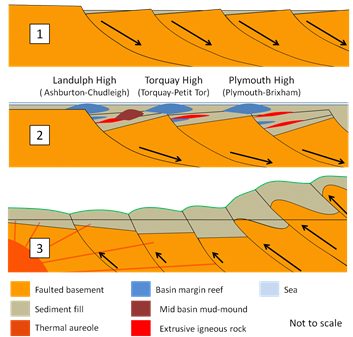 Figure 3 (right): The sedimentary and tectonic evolution of the South Devon Basin. 1. Early Devonian. The crust is stretched and extensional basins form by faulting. 2. Mid Devonian. Basin extension continues and carbonate sediments and reefs build on basinal highs, maintained by the sliding and rotation of the crustal blocks. Igneous rocks (lava and volcanic ashes) are extruded nearby, having risen to the surface along the faults. 3. Composite late Carboniferous to early Permian. Tectonic compression re-fits the crustal blocks and the sediments are thrust out of the basins, being eroded away as they rise. Basin closure took place from SW to NE in stages. Finally, the Dartmoor granite was intruded nearby and heat effects and mineralisation extend into the area.
Figure 3 (right): The sedimentary and tectonic evolution of the South Devon Basin. 1. Early Devonian. The crust is stretched and extensional basins form by faulting. 2. Mid Devonian. Basin extension continues and carbonate sediments and reefs build on basinal highs, maintained by the sliding and rotation of the crustal blocks. Igneous rocks (lava and volcanic ashes) are extruded nearby, having risen to the surface along the faults. 3. Composite late Carboniferous to early Permian. Tectonic compression re-fits the crustal blocks and the sediments are thrust out of the basins, being eroded away as they rise. Basin closure took place from SW to NE in stages. Finally, the Dartmoor granite was intruded nearby and heat effects and mineralisation extend into the area.
Figure 4 (below): Sedimentary textures in a block of Red Petitor marble, Petit Tor Quarry, St. Marychurch, Devon. Specimen 28, Watson Collection, Sedgwick Museum, Cambridge (Buildings Guide Group 6, E/CB/1). Fig. 4a: The marble – a 115mm wide block. Contrast is digitally enhanced to aid interpretation. Fig. 4b: Marble map at 1:1 scale showing the distribution of the main sedimentary features. Key and explanatory captions are included in the figure. The marble shows evidence of early uplift and exposure to erosion by rainwater, with the formation of small dissolution cavities and the removal of marine shell material. Marine mud then filled the vacated spaces.
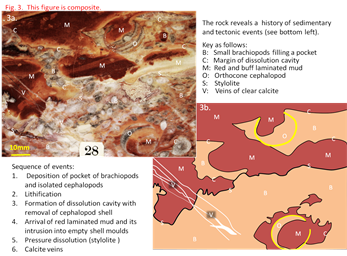 Until the start of my Devonshire marble project, perhaps a dozen building interiors were known, mostly anecdotally, and most without detail of variety or provenance. Now over 70 UK examples are recorded and documented, with a further dozen or more unvisited ‘probables’. These buildings contain columns, panels, reredos, chancel screens, pulpits, fonts, pavement, stairways and whole galleries executed in Devonshire. Some use Devonshire on the outside (e.g. County Chambers, Queen Street, Exeter, a charming mid to late 19th Century building). Two of the finest examples of interior use are St. John’s Church, Torquay (1885, mainly varieties of Ashburton, Petitor, Lummaton and Ogwell.) and Birmingham Art Gallery and Museum (1885, mainly varieties of Ogwell, Ashburton and Petitor.). Many more remain to be discovered.
Until the start of my Devonshire marble project, perhaps a dozen building interiors were known, mostly anecdotally, and most without detail of variety or provenance. Now over 70 UK examples are recorded and documented, with a further dozen or more unvisited ‘probables’. These buildings contain columns, panels, reredos, chancel screens, pulpits, fonts, pavement, stairways and whole galleries executed in Devonshire. Some use Devonshire on the outside (e.g. County Chambers, Queen Street, Exeter, a charming mid to late 19th Century building). Two of the finest examples of interior use are St. John’s Church, Torquay (1885, mainly varieties of Ashburton, Petitor, Lummaton and Ogwell.) and Birmingham Art Gallery and Museum (1885, mainly varieties of Ogwell, Ashburton and Petitor.). Many more remain to be discovered.
The rock
Marble, to most of us, means a recrystallised limestone; but this is certainly not what the mid- to Late Devonian Limestones of Devon are like. These ‘marbles’ still retain their original fossil and sediment detail, even down to some of the original radiaxial-fibrous marine calcite cements that precipitated in empty reef cavities.
Figure 5. Clustered shafts of polished British stones surround a crossing pier at St John’s College Chapel. Cambridge. The shafts are labelled and include two Devonshire varieties.
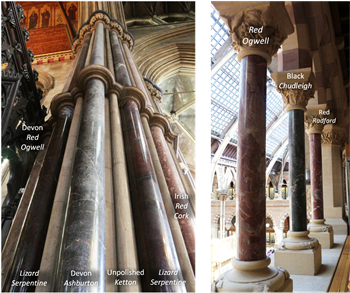 Sedimentary basins started to develop across what became south-west Britain in the early Devonian3 some 410 million years ago, in response to stretching, thinning and faulting of the crust - all attributable to a complex interplay of plate tectonic movements during the final stages of the assembly of NW Europe4.
Sedimentary basins started to develop across what became south-west Britain in the early Devonian3 some 410 million years ago, in response to stretching, thinning and faulting of the crust - all attributable to a complex interplay of plate tectonic movements during the final stages of the assembly of NW Europe4.
By the Middle Devonian the ‘South Devon Basin’ was filling with carbonate sediments organised into reefs and lagoons. There was a worldwide trend to carbonates at this time, becoming one of our most important reef-forming periods5. Some basins were huge (the Canning Basin in NW Australia extending across more than 150,000 km2). The South Devon Basin was a fraction of that, perhaps up 2000 km2, allowing for later crustal shortening. It all came as a response to worldwide sea-level rise6, which drowned basin margins, inhibited the incursion of clastics and allowed carbonate-secreting organisms to get into full swing. Some areas sometimes shallowed to mudflats and even underwent subaerial exposure as minor sea-level cycles tussled with local tectonics.
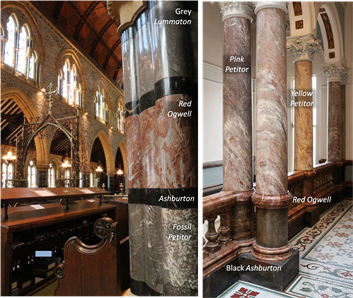 Figure 6 (left). Devonshire marbles in the first floor gallery at Oxford Museum of Natural History. Marble varieties are captioned and their localities are shown in Fig.1. Red Radford comes from near Plymouth. (right): Compound shaft made of drums of Devonshire marble, chancel arcade, St John’s Church, Torquay. Marble varieties are captioned and their localities are shown in Fig. 2.
Figure 6 (left). Devonshire marbles in the first floor gallery at Oxford Museum of Natural History. Marble varieties are captioned and their localities are shown in Fig.1. Red Radford comes from near Plymouth. (right): Compound shaft made of drums of Devonshire marble, chancel arcade, St John’s Church, Torquay. Marble varieties are captioned and their localities are shown in Fig. 2.
A switch from basin extension and subsidence to compression and uplift began towards the end of the Devonian3,4. Carbonate reef and lagoon sediment was now a good few hundred metres thick. First it became exposed, cracked, fissured, weathered and injected with extraneous sediment; then it was entombed beneath a substantial thickness of clastic mud and sand, derived from the advancing tectonic slices.
The new compressional regime lasted well into the Carboniferous, during which time the limestones became buried, fractured, sheared, veined and stylolitised. Some even became cleaved as Variscan basin-inversion swept across, but burial was never sufficient to induce recrystallisation. The usual story is one of ‘detail lost – marbles gained’; but in this region the nearest thing to that occurred after Permian erosion and intrusion of Cornubian granites had returned the thrusted and folded core of the orogen to surface.
Locally, phreatic haematisation soaked the limestones in a mix of oxic and anoxic water to redden and alter them. In this shallow but intensely duteric environment, they began to lose detail. Radiaxial fibrous marine calcites, for example, became first white, then red and blocky, and finally haematite. For the most part, limestones retained a mix of original sedimentary plus subsequent tectonic textures.
Figure 7 (below). The textural evolution of Devonshire marble. Events/ processes are based upon direct observation of polished samples, stone in buildings and rock at outcrop. No examples show all texturing events. The tectonic textures have not been reconciled with the known separate compressive deformations (D1 to D3), e.g. Leveridge et al., 2002, Leveridge et al., 2003)
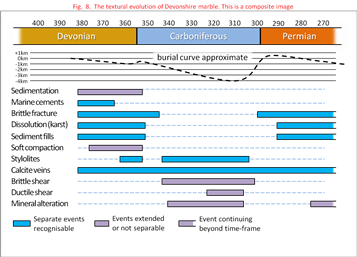 Rock to block
Rock to block
Panels of best Devonshire grace the interiors of some of the finest marble buildings in Britain. The Fitzwilliam Museum in Cambridge, for example, has stair panels (1875) that constitute the best outcrops of Ogwell mud-mound facies to be found anywhere. Added to that, one of the specimen marble tables lay unrecognised on the first floor gallery there for years, before being identified during this research as the probable work of John Woodley, the south Devonshire master mason. Woodley managed to beat-off some of the best Derbyshire marble-table crowd to a Prize Medal at the Great Exhibition of 1851. This was no mean feat, for the Derbyshire industry was heavily sponsored both by Aristocracy and Royalty. Confusingly, it was the 6th Duke of Devonshire who was behind the Derbyshire manufacturers and, judging by his own stone artefact collection, we could guess that His Lordship had never even visited Devonshire. What he must have said about Woodley’s victory is not recorded.
Woodley tables are now prized possessions. A large one, exactly fitting the description of the Woodley table exhibited at the Great Exhibition, occupies the stairway mezzanine at the Cromwell Road entrance to the Natural History Museum Earth Galleries in South Kensington, London. Radial–patterned, fit for an Arthurian gathering, it is presented with no provenance history apart from its inscription ‘DEVONSHIRE MARBLE’ – surely the mark of an assertive exhibition-piece. With the help of Colin Scrutton, a document now describes and identifies the marbles and fossils in this important table.
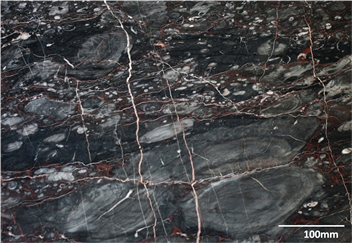 Figure 8. Ashburton marble. Typically dark grey with an abundance of fossils.The large grey banded ovate objects are stromatoporoids and some of the smaller white ones are corals. This is now compacted, stylolitised, veined and sheared. Together with its host formation, this dark organic-rich rock might once have made a fine hydrocarbon source rock!
Figure 8. Ashburton marble. Typically dark grey with an abundance of fossils.The large grey banded ovate objects are stromatoporoids and some of the smaller white ones are corals. This is now compacted, stylolitised, veined and sheared. Together with its host formation, this dark organic-rich rock might once have made a fine hydrocarbon source rock!
In the great entrance arch just below this mezzanine can be found the rare green Kitley marble, an unusual Devonian serpentine which probably is recrystallised (but look at it carefully). In the abutments there is also Pink Petitor. At nearby Brompton Oratory are magnificent Plymouth Radford Red marbles in columns, and a grey stromatoporoid-rich variety in the great pilasters. In the opposite direction from the museum is St. Augustines’ Church on Queen’s Gate. Here you can find a wonderful William Butterfield interior (1876) featuring more of the Petitor range as well as Red Ogwell, Black Ogwell, Ashburton and a fine font bowl in solid Derbyshire crinoidal.
Marble industry
Devonshire’s marble industry operated from works at opposite ends south Devon, Plymouth and Torquay. Buildings and artefacts are usually silent about their stones, so crucial in unlocking this information has been the building stone collection at the Sedgwick Museum, Cambridge. Their 26 precious polished Devonshire marble specimens were mostly supplied by Plymouth and Torquay manufacturers. The Devonshire stones (along with hundreds of others) were catalogued and fully documented early last Century by John Watson7, with examples of where the stones were used. This collection was crucial in solving some mysteries. Several specimens, the Petitor varieties, come from just one area among the cliffs and beaches at Babbacombe near Torquay.
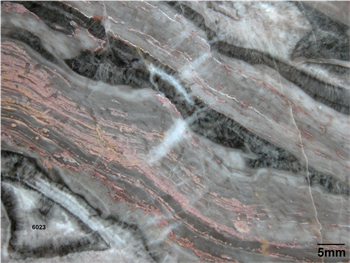 Figure 9. Grey Petitor marble from Petit Tor, Babbacombe, nr. Torquay. Banded light grey and pink is a leaf stromatoporoid Caunopora with an intergrown tabulate coral, Syringopora. Banded dark grey and white is radiaxial fibrous calcite, precipitated directly from sea-water. The stromatoporoids grew in extended sheets and the marine cement was deposited between them, probably all developing on the front of a Devonian reef.
Figure 9. Grey Petitor marble from Petit Tor, Babbacombe, nr. Torquay. Banded light grey and pink is a leaf stromatoporoid Caunopora with an intergrown tabulate coral, Syringopora. Banded dark grey and white is radiaxial fibrous calcite, precipitated directly from sea-water. The stromatoporoids grew in extended sheets and the marine cement was deposited between them, probably all developing on the front of a Devonian reef.
Were it not for the Rev. John Swete, dilettante West Country artist and writer, we might have missed the connection between Petitor marble and a man who, almost by chance, became the founding father of the Devonshire marble industry. Robert Fulton (1765-1815) was a promising American artist, inventor and engineer who came to Britain in 18877. Perhaps his ambition to study painting here was just a cover, for he had already established an interest in steam power. Indeed, it was not long before he moved on to France, dabbling in submarines and explosives for a certain Napoleon Bonaparte.
Swete crossed Fulton’s path on one of his many Devon rambles8. He describes descending into Petit Tor cove where “a Mr Fulton an ingenious gentleman” had erected “a large building, which contains a Machine for the sawing of blocks of marble.... by the means of a single horse turning a wheel”. “This of his own invention”, notes Swete, it would “saw as much stone in a day as a Labourer hath been accustom’d to do in fifteen”.
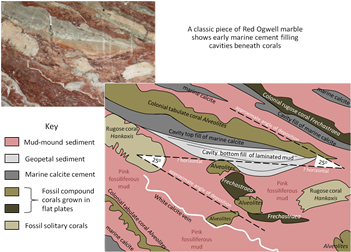 Figure 10. Ogwell marble in a stair panel at the Fitzwilliam Museum, Cambridge. Plates of rugose and tabulate corals apparently lie parallel to the sediment. However, a geopetal fill (fossil spirit level) of laminated mud in the cavity beneath the large Alveolites plate suggests that the corals themselves lay at an angle. If so, there has been minimal compaction since. The Ogwell facies is thought to be a carbonate mud-mound that had inclined flanks. There are three panels showing this coral/ geopetal fill depositional slope relationship in the museum and they seem to confirm the model.
Figure 10. Ogwell marble in a stair panel at the Fitzwilliam Museum, Cambridge. Plates of rugose and tabulate corals apparently lie parallel to the sediment. However, a geopetal fill (fossil spirit level) of laminated mud in the cavity beneath the large Alveolites plate suggests that the corals themselves lay at an angle. If so, there has been minimal compaction since. The Ogwell facies is thought to be a carbonate mud-mound that had inclined flanks. There are three panels showing this coral/ geopetal fill depositional slope relationship in the museum and they seem to confirm the model.
Now visualise, by complete contrast, the urban splendour of the grand Adam brothers’ neoclassical (Georgian) terraced development of The Adelphi, off the Strand, headquarters of the Society for the Encouragement of Arts, Commerce and Manufactures (SEACM, now the Royal Society of Arts). Apparently, Fulton had sent them a model of his Devonshire horse-powered sawing machine, for he received in response their Silver Medal for services to ‘mechaniks’ in 17949.
The turn of the 19th Century was not a good time for coastal quarrying. With the Napoleonic threat increasing, Fulton soon departed to work for the French. Perhaps aware of this, and in any case to keen to promote the use of British marble over European competition, SEACM resolved (1804) to set up a long term reward, or ‘Premium’, for notable examples of British marbles. In 1809 a claimant is recorded; a Mr JP Hubbard, of Picket Street, Temple Bar6. He had a fine holiday home in the Cliffs at Babbacombe and was already active in the former Fulton quarry at Petit Tor.
His account of the quarry, delivered to the Society in support of his submission, is a gem. The quarry was 12 acres in extent, on the beach and flooded at high tide. A specially-built wharf enabled the loading of stone directly into boats bound for Teignmouth. Hubbard had available panels and columns of marble five feet or more, with a sale price at four shillings per linear foot, half the price of ‘foreign’, and he believed that the number of workmen he could soon employ would be 60 to 100.
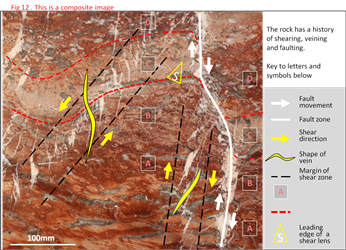 Figure 11. Shearing, faulting and bedding deformation in Red Petitor marble, sanctuary pavement, St. John’s Church, Torquay. The key to symbols and letters used are included in the figure. The original bedded sediment (A-D) has experienced both plastic deformation (folding) and brittle deformation (veining). The pattern of deformation with two converging sets of veins (yellow symbols) is typical of compression in the direction top right and bottom left, indicated by the triangle marked ‘S’. Individual parallel sets of veins are usually termed ‘en-echelon’ sets whilst convergent patterns of these are called ‘conjugate sets’. The fault (white symbols) was probably a final phase.
Figure 11. Shearing, faulting and bedding deformation in Red Petitor marble, sanctuary pavement, St. John’s Church, Torquay. The key to symbols and letters used are included in the figure. The original bedded sediment (A-D) has experienced both plastic deformation (folding) and brittle deformation (veining). The pattern of deformation with two converging sets of veins (yellow symbols) is typical of compression in the direction top right and bottom left, indicated by the triangle marked ‘S’. Individual parallel sets of veins are usually termed ‘en-echelon’ sets whilst convergent patterns of these are called ‘conjugate sets’. The fault (white symbols) was probably a final phase.
Certainly this impressed SEACM, for not only did it display his 60 polished samples in their Great Room, but they awarded Hubbard their Gold Medal for the session. Devonshire marble had come of age and, indeed, the competition was out of sight. Sadly, so now are those 60 polished samples of Petitor marble; nor is there any sign of Fulton’s model.
Medal notwithstanding, Hubbard’s Petit Tor enterprise failed to prosper, and he suffered big losses during a storm. The costal quarrying business must have remained difficult and Hubbard had to bring in families from elsewhere to work and supervise his ambitious enterprise. One such was that of Daniel Woodley, father of master mason John Woodley, later of marble table fame.
Despite the eventual British victory the economy was in a mess and marble was probably not in great demand. But gradually the East India Company, inter alia, breathed new life into Imperial Britain’s economy and with the increased wealth the demand for marble embellishment burgeoned. The fame of Petit Tor quarry became assured for the next 75 years or more and it even became a tourist attraction, as a contemporary print testifies. The Victorian building boom, especially in Gothic churches, arrived with the 1840s.
Figure 12 (below). Mapping complex textures in a Red Ipplepen marble, nave shaft, Unitarian Church, Todmorden, West Yorkshire. The quarries were at Ipplepen, near Newton Abbot, Devon and this is likely to be from Barton Quarry, Ipplepen. a: The original Ipplepen marble in a nave shaft. Scale as indicated. b: Marble map, 1:1 scale, of the textures in a. These are numbered in probable order of development in the inset key.
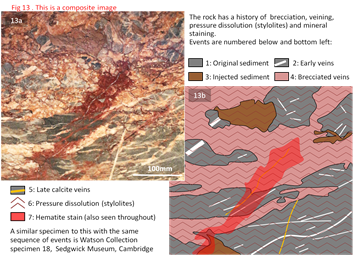 Petit Tor enigma
Petit Tor enigma
Nudist members of the Society, especially male ones, may know Petit Tor Cove in a more social context. Its geology, though, and that of adjacent Petit Tor Down and nearby bays, is dominated by mid- Devonian limestones and Permian breccias.
Petit Tor marbles (Petitor) are the most spectacular and varied in the Devonshire palette. They are usually distinguished by the abundance of grey banded early marine cement and some show a long history of early- to late fracturing, stylolitisation and multiple veining. Petitor can be haematised, dolomitised or limonitised giving a range of colours from pink to red or yellow.
In fact, to a limestone lover it is often a complete mess. In 1832, De la Beche11 saw it as “a breccia composed of large blocks (some many tons in weight) ......the cementing matter is sometimes a red sandstone, at others a reddish clay. The marble (known as Babbacombe marble) is wholly derived from these blocks”. It is not a bad description of what we see today, and no other Devonshire marble matches this confused geology.

Figure 13. The great Devonshire specimen marble table at the Natural History Museum, South Kensington, London. This is the largest of just 10 such specimen marble tables so far recorded.
The mess at both specimen and outcrop scale has dogged interpretation at Petit Tor for a good while. In the 1830s, De la Beche12 first interpreted it as a rubble layer positioned above the main limestone in the cliffs; later he suggested it was at the same level but on the other side of an anticline. Even the main mass of limestone at Petit Tor Down has an unclear basal relationship, sheared and thrusted against the younger Saltern Cove Formation.
More recently, Brian Leveridge and co-workers13 discounted any direct link between the Breccia and the main limestone body, mapping it as a rubble of Devonian limestone that arrived with the breccias and sands of the Late Permian.
Figure 14. “Marble Quarries, at Petit Tor, near Torquay”. Lithograph, Villeneuve, 1828. The quarry was a tourist attraction through much of the 19th Century. In 1828 it was in the hands of Daniel Woodley. Note Lighthouse and Cottage – possibly dating from Hubbard, neither of which is now recognisable.
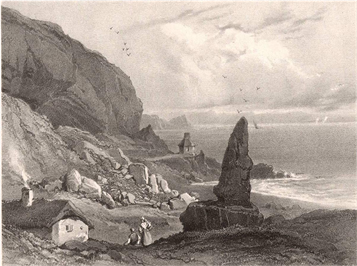 My own picture confirms the separation. Made of Mid Devonian limestone, the Petit Tor Breccia (the Petitor marble horizon) rests on the Late Devonian Saltern Cove formation; but perhaps we should take this relationship at face value. The Breccia could be a Devonian mass flow deposit of ‘Saltern Cove age’ rather than Permian. As such it would be a Devonian rubble layer brought to surface and then reburied in the late Permian, rather than arriving as a thick debris layer in unknown circumstances during the Late Permian.
My own picture confirms the separation. Made of Mid Devonian limestone, the Petit Tor Breccia (the Petitor marble horizon) rests on the Late Devonian Saltern Cove formation; but perhaps we should take this relationship at face value. The Breccia could be a Devonian mass flow deposit of ‘Saltern Cove age’ rather than Permian. As such it would be a Devonian rubble layer brought to surface and then reburied in the late Permian, rather than arriving as a thick debris layer in unknown circumstances during the Late Permian.
It could represent an Upper Devonian basin slope-failure for example, and there are examples elsewhere of big loose mid-Devonian limestone boulders within the Late Devonian Saltern Cove formation so that bits were certainly falling off at the appropriate time. If the Breccia is a submarine mass flow deposit of Late Devonian age, then the unconformity needs to be above it and its arrival pre-dates tectonism. If it isa landslide of Permian age then the unconformity must be beneath it and the marble rubble will have been tectonised before it arrived. Easy to say; difficult to tell. The present state of outcrop and accessibility makes it a very hard call - now there’s a challenge!
Figure 15 (right). Aerial view of the area around Petit Tor, St. Marychurch with geological boundaries and locality details superimposed.
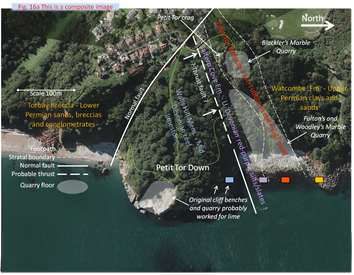 The story of Devonshire marbles, featuring great geology, spectacular buildings and some unexpected historical and architectural associations, is explored in a new two-volume book to be published by the Geologist’s Association in the Autumn.
The story of Devonshire marbles, featuring great geology, spectacular buildings and some unexpected historical and architectural associations, is explored in a new two-volume book to be published by the Geologist’s Association in the Autumn.
References
- Tomlinson, J.M., 1996. Derbyshire Black Marble. Peak District Mines Historical Society Special Publication 4. Peak District Mining Museum, Matlock Bath, Derbyshire. 95pp.
- Price, M.T. 2007. The source book of decorative stone. Quintet Publishing. 288pp.
- Leveridge, B.E., 2011. The Looe, South Devon and Tavy basins: the Devonian rifted passive margin successions. Proceedings of the Geologists’ Association 122 (2011) 616–717.
- Leveridge, B.E. & Shail, R.K., 2011. Marine Devonian Stratigraphy of Great Britain. Proceedings of the Geologists’ Association 122, 540–567.
- Copper, P. 2002. Silurian and Devonian reefs: 80 million years of global greenhouse between two ice ages. In: KIESSLING, W., FLUGEL, E. & GOLONKA, J. (eds), Phanerozoic Reef Patterns. Society of Economic Paleontologists and Mineralogists, Special Publication 72, 181-238.
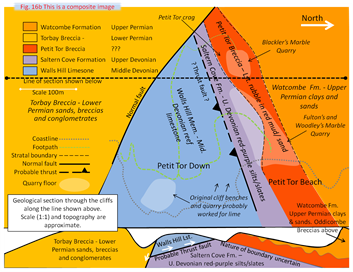 Haq, B.U. & Schutter, S.R., 2008. A Chronology of Paleozoic Sea Level Changes. Science, 322, 64-68.
Haq, B.U. & Schutter, S.R., 2008. A Chronology of Paleozoic Sea Level Changes. Science, 322, 64-68.- Dickinson, H.W., 1913. Robert Fulton Engineer and Artist his life and works. John Lane London 333pp. (https://archive.org/details/robertfultoneng00dickgoog)
- Swete, Rev. J., 1789-1800. Travels in Georgian Devon. The illustrated journals of the Reverend John Swete. Todd Gray and Margery Rowe, eds. 4vols, Devon Books, Tiverton.
- Fulton, Robert, 1794 (reference to). Transactions of the Society for the Encouragement of Arts Manufactures and Commerce. Volume 12 , p. 329 (web search: Transactions of the society instituted at London 1794 vol 12)
- Hubbard, John, 1809 (reference to and address by). Transactions of the Society for the Encouragement of Arts Manufactures and Commerce Volume 27, pp. 19 and 85 (web search: JP Hubbard gold medal marble Transactions 1809)
- De la Beche, H.T., 1832. A geological manual. Treuttel and Wurz, Paris and Strasburgh. Second Edition, Richard Taylor, London, 564pp.
- De la Beche, H.T., 1839. Report on the Geology of Cornwall, Devon and West Somerset. Memoir of the Geological Survey, Great Britain, Longmans, London.
- Leveridge, B.E., Scrivener, R.C., Goode, A.J.J., Merriman, R.J., 2003. Geology of the Torquay district – a brief explanation of the geological map. Sheet Explanation of the British Geological Survey. 1:50 000 Sheet 350 Torquay (England and Wales).
- Leveridge, B.E., 2011. The Looe, South Devon and Tavy basins: the Devonian rifted passive margin successions. Proceedings of the Geologists’ Association 122 (2011) 616–717.